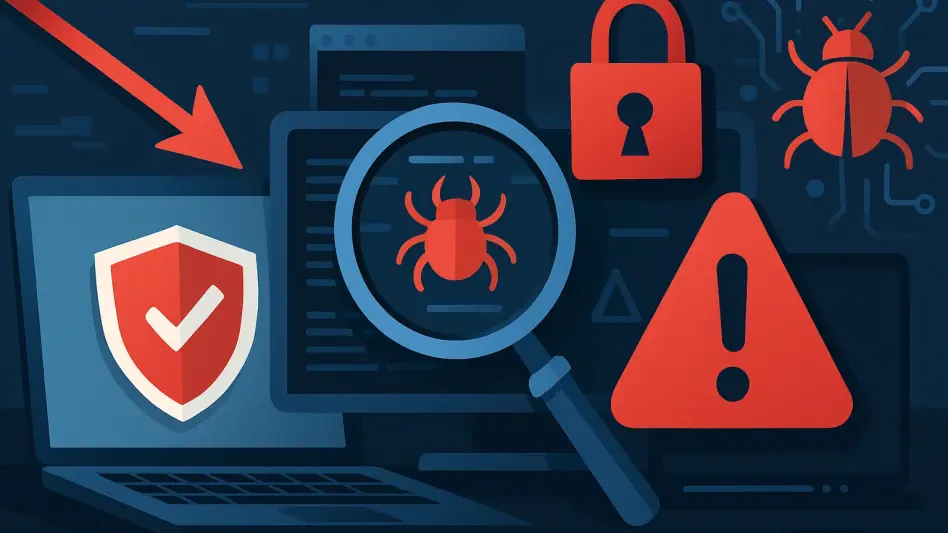Picture a cyber threat so cunning that it transforms unsuspecting users into unwitting accomplices in their own digital demise, manipulating trust in everyday online interactions into a weapon of destruction. This is the chilling reality of ClickFix, a sophisticated social engineering technique that has emerged as a significant concern in the cybersecurity landscape. Disguised as legitimate browser verification challenges, this method tricks individuals into executing malicious commands, effectively turning a routine click into a gateway for malware. Detailed by leading security experts, ClickFix represents not just a singular tactic but a growing trend in cybercrime, where ease of access to advanced tools empowers even novice attackers. Through phishing kits like the IUAM ClickFix Generator, the barrier to launching devastating attacks has been drastically lowered. This article delves into the mechanics of this deceptive threat, explores its real-world impact, and examines the challenges it poses to modern cybersecurity defenses. As cybercriminals continue to exploit human behavior over technical vulnerabilities, understanding this menace becomes crucial for safeguarding digital environments.
The Deceptive Core of ClickFix
At the heart of this cyber threat lies a deeply manipulative strategy that preys on human trust in familiar online processes. ClickFix operates by mimicking the verification prompts commonly encountered on websites, such as those “prove you’re human” challenges associated with Content Delivery Networks or cloud security services. These fake prompts are crafted with alarming precision to appear authentic, convincing users to follow seemingly harmless instructions. The danger emerges when individuals, believing they are complying with standard security measures, copy and paste commands that ultimately compromise their devices. This reliance on social engineering rather than exploiting software flaws makes the technique particularly difficult to detect and counter with traditional defenses.
What amplifies the risk is the accessibility of this method to a wide range of threat actors. Packaged into user-friendly phishing kits, the technique has been democratized, allowing even those with minimal technical expertise to orchestrate sophisticated attacks. The IUAM ClickFix Generator, for instance, offers a platform where attackers can customize their phishing pages to suit specific targets. This commoditization of cybercrime tools through phishing-as-a-service models marks a troubling shift in the landscape, enabling a surge in attacks that exploit human instincts over technical gaps. As these tools spread, the potential for widespread harm grows, demanding a reevaluation of how security measures address user behavior.
Mechanics Behind the Malicious Trickery
Understanding how this threat operates reveals the sinister simplicity of its design, which hinges on deceiving users into performing actions that seem routine. The process begins when a user encounters a phishing page crafted to resemble a legitimate browser challenge. Upon interacting with elements like a fake CAPTCHA, malicious JavaScript covertly copies harmful commands to the user’s clipboard. A pop-up or overlay then instructs the individual to paste and execute these commands—often through familiar tools like the Windows Run dialog or macOS Terminal—under the guise of completing a verification step. Unbeknownst to the user, this action installs malware directly onto their device, bypassing many conventional security barriers.
The brilliance of this approach lies in its exploitation of trust in standardized web interactions, making it a formidable challenge for even tech-savvy individuals to spot the deception. Unlike traditional attacks that target system vulnerabilities, this method turns the user into an active participant in the compromise. Once the malicious command is executed, the damage can range from data theft to full system control by attackers. The seamless integration of these fake prompts into everyday browsing experiences underscores the urgent need for heightened awareness and new defensive tactics that focus on educating users about such deceptive practices, rather than solely relying on technical solutions.
Inside the IUAM ClickFix Generator
Central to the proliferation of this cyber threat is a tool known as the IUAM ClickFix Generator, a web-based platform that equips cybercriminals with the means to create highly tailored phishing pages. Discovered on a publicly accessible server, this generator provides an intuitive interface that allows attackers to customize elements like page titles, instructional messages, and even footer notes to enhance the authenticity of their lures. Such customization ensures that the fake verification challenges closely mimic legitimate ones, increasing the likelihood that users will follow the prompted actions without suspicion. This tool essentially lowers the technical barrier, enabling even those with limited skills to craft convincing attacks.
Beyond basic customization, the generator boasts advanced features that make it particularly dangerous across diverse environments. Capabilities such as operating system detection allow attackers to deliver specific commands tailored for Windows or macOS users, while clipboard injection ensures malicious code is seamlessly copied for execution. Additional functionalities like mobile blocking—prompting users to switch to desktop devices—and obfuscation techniques further enhance the tool’s effectiveness by evading detection and adapting to different victim profiles. This level of sophistication in a widely accessible kit signals a troubling trend where cybercrime tools are not only powerful but also user-friendly, amplifying the scale of potential threats in the digital realm.
Real-World Consequences of ClickFix Attacks
The theoretical danger of this technique transforms into tangible harm through documented campaigns that have already wreaked havoc on unsuspecting users. One notable instance involved a Windows-targeted attack delivering DeerStealer, an information-stealing malware. In this campaign, victims interacting with a fake verification page had malicious PowerShell commands copied to their clipboard, accompanied by instructions to execute them via the Run dialog. The result was the installation of malware that harvested sensitive data, demonstrating how a single misguided action by a user could lead to significant breaches of personal and financial security. Such cases highlight the immediate risks posed by these deceptive tactics.
Another alarming campaign showcased the cross-platform adaptability of these attacks, targeting both Windows and macOS users with the Odyssey infostealer. Variations in phishing pages delivered tailored commands depending on the detected operating system, ensuring maximum impact across different environments. For macOS users, Base64-encoded commands executed in the background installed the malware, while Windows users faced alternative payloads or decoy instructions to maintain the illusion. This ability to adapt attacks to multiple platforms underscores the expansive reach of ClickFix, complicating defensive efforts and exposing a broader pool of potential victims to sophisticated cyber threats that exploit user trust with devastating precision.
Ecosystem Expansion and Variations
A closer examination of phishing pages associated with this threat reveals a complex and evolving ecosystem that fuels its spread. Not all instances of these deceptive pages are identical; variations in HTML structure, command delivery mechanisms, and visual design suggest the existence of multiple kits or independent adaptations inspired by the same core concept. Some pages lack advanced features like operating system detection, while others present simplified spoofs of browser challenges, indicating that different developers or groups may be customizing the base technique to suit their needs or skill levels. This diversity points to a growing market for such tools within cybercriminal circles.
The presence of these variations also hints at a competitive commercial network where developers and affiliates collaborate to distribute and monetize these phishing kits. Such an ecosystem likely involves a range of actors, from creators of the original tools to those who tailor and deploy them in specific campaigns. This collaborative model mirrors broader trends in cybercrime, where techniques are commoditized and sold as services, enabling rapid proliferation across the internet. As this network expands, the adaptability and reach of ClickFix continue to grow, presenting an ongoing challenge for cybersecurity professionals who must track and counter an ever-shifting array of threats in this dynamic landscape.
Social Engineering: The Heart of the Threat
What distinguishes this cyber tactic from many others is its profound reliance on social engineering, exploiting human behavior rather than technical weaknesses. By presenting prompts that mimic trusted verification processes, attackers capitalize on the natural inclination to comply with familiar instructions encountered during online navigation. This approach bypasses the need for complex exploits or zero-day vulnerabilities, instead turning user trust into a direct pathway for compromise. The psychological manipulation at play makes this threat uniquely insidious, as it leverages everyday digital habits against the very individuals performing them.
Traditional security measures, often designed to patch software flaws or block malicious code, struggle to address this human-centric attack vector. Firewalls and antivirus programs cannot prevent a user from manually executing a harmful command if they believe it to be legitimate. This gap in protection highlights a critical vulnerability in current cybersecurity frameworks, where the human element remains the weakest link. Addressing this challenge requires a shift in focus toward educating users about the risks of following unsolicited instructions online, alongside developing detection systems that can identify and flag deceptive prompts before they reach their intended targets.
Cybersecurity Challenges and Future Defenses
The emergence of this threat, amplified by accessible tools like the IUAM ClickFix Generator, poses formidable challenges to the cybersecurity community. The ease with which attackers can customize and deploy phishing pages means that these threats can scale rapidly, reaching a vast audience of potential victims with minimal effort. This scalability, combined with the low skill threshold for using such kits, results in a surge of attacks that overwhelm traditional response mechanisms. Security teams must now contend with a deluge of varied threats, each tailored to exploit specific user behaviors or system configurations, stretching resources and expertise to their limits.
Equally concerning is the multi-platform nature of these attacks, which target both Windows and macOS environments with equal precision. This cross-platform capability complicates defense strategies, as solutions must account for diverse operating systems and user interactions. Moving forward, a dual approach that combines technical innovation with user education appears essential. Advanced detection tools, capable of identifying malicious domains and phishing behaviors, must work in tandem with awareness campaigns that teach individuals to question suspicious prompts. As cybercriminals refine their tactics, the cybersecurity field must adapt by prioritizing proactive measures and fostering a culture of vigilance to stay ahead of these evolving dangers.
Reflecting on a Persistent Menace
Looking back, the uncovering of this deceptive technique and the associated IUAM ClickFix Generator marked a pivotal moment in understanding the evolving nature of cyber threats. Campaigns that delivered malware like DeerStealer and Odyssey revealed the stark reality of how social engineering could turn routine online actions into catastrophic breaches. The variations in phishing implementations and the growth of a supporting commercial ecosystem underscored the adaptability and persistence of this challenge, as attackers collaborated to maximize their impact. Security solutions, ranging from advanced URL filtering to behavioral threat protection, played a vital role in mitigating these risks during critical moments of exposure.
For the future, the focus must shift toward actionable strategies that address both the technical and human dimensions of this threat. Developing more sophisticated detection mechanisms to identify fake verification pages before they reach users remains a priority, as does enhancing cross-platform security measures to protect diverse environments. Equally important is the push for widespread user education, empowering individuals to recognize and resist deceptive prompts. By fostering collaboration through threat intelligence sharing and investing in innovative defenses, the cybersecurity community can build resilience against such manipulative tactics, ensuring safer digital interactions for all in the years ahead.








